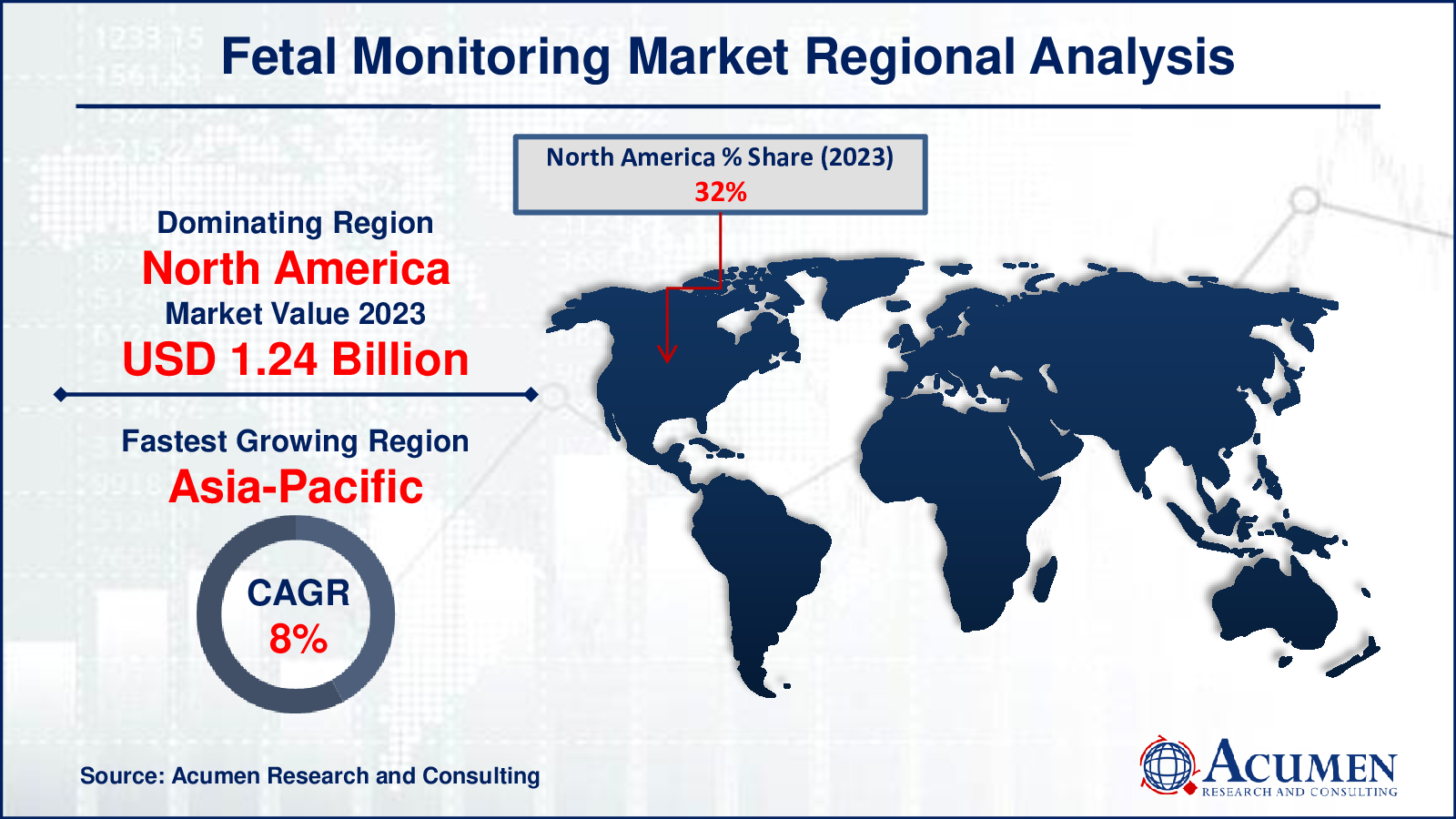Fetal Monitoring Market Size - Global Industry, Share, Analysis, Trends and Forecast 2024 - 2032
Published :
Report ID:
Pages :
Format :
Fetal Monitoring Market Size - Global Industry, Share, Analysis, Trends and Forecast 2024 - 2032
Report Coverage
- Industry Dynamics
- Market Size and Forecast Data
- Segment Analysis
- Competitive Landscape
- Regional Analysis with a Niche Focus on Country-Level Data
- High Level Analysis - Porter's, PESTEL, Value Chain, etc.
- Company Profiles of Key Players
- Option to Customize the Report As Per Your Specific Need
Request Sample Report
The Fetal Monitoring Market Size accounted for USD 3.87 Billion in 2023 and is estimated to achieve a market size of USD 7.16 Billion by 2032 growing at a CAGR of 7.1% from 2024 to 2032.
Fetal Monitoring Market Highlights
- The global fetal monitoring market is projected to reach USD 7.16 billion by 2032, growing at a CAGR of 7.1% from 2024 to 2032
- The North America fetal monitoring market was valued at USD 1.24 billion in 2023
- Asia-Pacific fetal monitoring market is expected to grow at a CAGR of 8% from 2024 to 2032
- Based on product, the ultrasound occupied USD 2.13 billion revenue in 2023
- The invasive method held around 74% share in the fetal monitoring market in 2023
- Increasing adoption of non-invasive and wireless fetal monitoring solutions is a key trend in the fetal monitoring market, boosting industry growth

Fetal monitoring is a medical procedure that tracks and assesses a fetus's health and well-being during pregnancy and labor. It uses a variety of ways to monitor fetal heart rate, movement, and other vital signs to ensure the fetus is developing normally and is not in distress. The primary purpose of fetal monitoring is to discover any difficulties early, allowing for appropriate actions that benefit both the mother and the baby. There are two types of fetal monitoring: external and internal. External monitoring uses ultrasound sensors placed on the mother's belly to detect fetal heartbeat and movement, whereas internal monitoring requires inserting a small electrode on the fetal scalp to obtain more precise data.
During labor, fetal monitoring is critical because it allows healthcare providers to make informed decisions about the delivery. Continuous fetal monitoring can provide real-time information regarding how the fetus is handling the stress of labor. This monitoring can detect fetal hypoxia, which is a shortage of oxygen, as well as irregular heart rate patterns that may demand medical procedures such as an emergency cesarean delivery. Overall, fetal monitoring is essential in modern obstetrics, considerably improving the safety and well-being of both mother and child during pregnancy and childbirth.
Global Fetal Monitoring Market Dynamics
Market Drivers
- Rising prevalence of high-risk pregnancies necessitating advanced fetal monitoring technologies
- Increasing awareness and demand for improved maternal and fetal healthcare
- Technological advancements in non-invasive and continuous monitoring devices
- Growing healthcare expenditure and better access to medical facilities
Market Restraints
- High cost of advanced fetal monitoring equipment limiting widespread adoption
- Lack of skilled healthcare professionals to operate complex monitoring systems
- Concerns about the accuracy and reliability of certain monitoring methods
Market Opportunities
- Expanding telemedicine and remote monitoring capabilities for rural and underserved areas
- Development of portable and user-friendly fetal monitoring devices for home use
- Increasing investment in research and development for innovative fetal health solutions
Fetal Monitoring Market Report Coverage
| Market | Fetal Monitoring Market |
| Fetal Monitoring Market Size 2022 | USD 3.87 Billion |
| Fetal Monitoring Market Forecast 2032 | USD 7.16 Billion |
| Fetal Monitoring Market CAGR During 2023 - 2032 | 7.1% |
| Fetal Monitoring Market Analysis Period | 2020 - 2032 |
| Fetal Monitoring Market Base Year |
2022 |
| Fetal Monitoring Market Forecast Data | 2023 - 2032 |
| Segments Covered | By Product, By Method, By Portability, By Application, By End User, And By Geography |
| Regional Scope | North America, Europe, Asia Pacific, Latin America, and Middle East & Africa |
| Key Companies Profiled | Arjo, Cardinal Health Inc., EDAN Instrument, Inc., FUJIFILM Holdings Corporation, General Electric Company, Koninklijke Philips N.V., MedGyn products, inc., Neoventa Medical AB, Natus Medical Incorporated., and Siemens AG. |
| Report Coverage |
Market Trends, Drivers, Restraints, Competitive Analysis, Player Profiling, Covid-19 Analysis, Regulation Analysis |
Fetal Monitoring Market Insights
Several significant reasons are driving the fetal monitoring market, including the increased demand for sophisticated healthcare solutions in maternal and fetal medicine. One of the key factors is the increasing occurrence of high-risk pregnancies, which needs the use of advanced monitoring systems to safeguard the health of both the mother and the kid. With rising awareness of maternal and fetal health, there is a greater need for enhanced monitoring systems that can offer accurate and timely information during pregnancy and childbirth. Technological breakthroughs have resulted in the creation of non-invasive and continuous monitoring technologies that improve patient comfort and safety. Furthermore, rising healthcare costs and improved access to medical facilities have contributed to the widespread use of these advanced monitoring systems.
Despite the strong growth drivers, the fetal monitoring systems market has a number of constraints that may limit its progress. One key problem is the high cost of modern fetal monitoring technology, which can be too expensive for many healthcare practitioners and patients, particularly those in low-income areas. The shortage of experienced healthcare workers capable of operating complicated monitoring systems further impedes market expansion. Furthermore, there are continuous worries regarding the accuracy and dependability of certain monitoring systems, which might undermine the faith and confidence of both healthcare providers and patients in these technologies.
The fetal monitoring systems market offers numerous prospects for growth and innovation. Telemedicine and remote monitoring's rising capabilities have the potential to significantly improve fetal healthcare access in rural and underserved areas. This can ensure that more pregnant women receive prompt and reliable monitoring, regardless of their location. Furthermore, the development of portable and user-friendly fetal monitoring technologies for home usage might enable pregnant mothers to play an active role in monitoring their pregnancies. Increased investment in R&D is another promising prospect, propelling the development of novel fetal health solutions that can improve the effectiveness and efficiency of monitoring systems. These opportunities suggest a bright future for the fetal monitoring business, with the potential for significant developments and enhancements in the coming years.
Fetal Monitoring Market Segmentation
The worldwide market for fetal monitoring is split based on product, method, portability, application, end-user, and geography.
Fetal Monitoring Market By Product
- Ultrasound
- Electronic Fetal Monitoring (EFM)
- Accessories and Consumables
According to the fetal monitoring industry analysis, ultrasound accounts for 55% of the fetal monitoring market due to its widespread acceptance and crucial role in prenatal care. It provides a non-invasive, real-time view of the fetus, allowing for a thorough evaluation of fetal development, anatomy, and health. Ultrasound technology has evolved tremendously, allowing for detailed images and Doppler capabilities to assess blood flow and spot potential anomalies early. Its safety, dependability, and efficacy make it a popular choice among healthcare providers and expectant moms. Furthermore, ultrasound is required for routine check-ups, high-risk pregnancies, and guided interventions, which contributes to its dominant market position.
Fetal Monitoring Market By Method
- Invasive
- Non-Invasive
Invasive methods account for 74% of the fetal monitoring market, owing to their accuracy and reliability in essential conditions. These techniques, such as fetal scalp electrodes and intrauterine pressure catheters, give direct and exact measures of fetal heart rate and uterine contractions, which are critical in high-risk births and difficult pregnancies. Invasive monitoring is frequently used when exterior approaches fail to offer sufficient information, assuring the safety of both the mother and the fetus. Its widespread use in hospitals and specialized medical settings, particularly for continuous and comprehensive monitoring during labor, reinforces its dominant market position.
Fetal Monitoring Market By Portability
- Portable
- Non-Portable
Portable fetal monitoring had the greatest market share of 62% in the global fetal monitoring market due to its convenience, ease of use, and cost-effectiveness. Portable fetal monitors are lightweight, compact, and readily transported by healthcare workers to various locations, making them ideal for usage in hospitals, clinics, and even at home. They also provide real-time data and warnings, which allow for timely interventions and reduce the risk of fetal problems. Furthermore, portable fetal monitors are generally less expensive than non-portable devices, making them a popular choice among many healthcare providers.
Fetal Monitoring Market By Application
- Intrapartum Fetal Monitoring
- Antepartum Fetal Monitoring
The antepartum fetal monitoring segment accounted for the largest share of 58% in the global fetal monitoring market due to the growing incidence of preterm labor and the increasing demand for early detection of fetal distress. Antepartum fetal monitoring is crucial for identifying potential complications in pregnant women between 24-40 weeks of gestation, enabling timely interventions and reducing the risk of adverse outcomes. The segment's popularity can be attributed to the availability of non-invasive and non-stress tests, such as Doppler ultrasound and cardiotocography (CTG), which provide valuable information on fetal well-being and allow healthcare providers to make informed decisions.
Fetal Monitoring Market By End User
- Hospitals and Maternity Hospitals
- Clinics
- Others
Hospitals and maternity hospitals dominated the fetal monitoring systems market, accounting for the largest share. This is because hospitals and maternity hospitals are the primary settings where fetal monitoring is performed, particularly during labor and delivery. The high demand for fetal monitoring in hospitals is driven by the need for continuous surveillance of fetal well-being, especially in high-risk pregnancies. Additionally, hospitals and maternity hospitals have a large patient volume, which increases the demand for fetal monitoring devices and services. As a result, hospitals and maternity hospitals are the primary end-users of fetal monitoring devices, driving the growth of the market.
Fetal Monitoring Market Regional Outlook
North America
- U.S.
- Canada
Europe
- U.K.
- Germany
- France
- Spain
- Rest of Europe
Asia-Pacific
- India
- Japan
- China
- Australia
- South Korea
- Rest of Asia-Pacific
Latin America
- Brazil
- Mexico
- Rest of Latin America
The Middle East & Africa
- South Africa
- GCC Countries
- Rest of the Middle East & Africa (ME&A)

Fetal Monitoring Market Regional Analysis
The global fetal monitoring market is considerable, with an increasing need for improved fetal monitoring technologies. Geographically, North America dominated the fetal monitoring market, with the greatest share. The region's well-established healthcare infrastructure, widespread use of sophisticated technology, and big patient population all contribute to its leadership position. The United States is North America's largest market, driven by rising demand for advanced fetal monitoring technologies, notably in hospitals and maternity facilities.
In Europe, the fetal monitoring market is also considerable, driven by rising maternal and fetal health awareness and the use of modern technologies. The region's well-established healthcare infrastructure, as well as government initiatives to enhance maternal and fetal health, all helps to drive growth. The Asia-Pacific area is predicted to be the fastest-growing market for fetal monitoring, driven by a growing middle class, rising healthcare spending, and increased awareness of maternal and fetal health. China and India, with their enormous populations and developing healthcare infrastructure, are projected to fuel market expansion in this region. Latin America, the Middle East, and Africa are also likely to rise significantly throughout the projection period, owing to increased government initiatives and rising awareness of maternal and fetal health.
Fetal Monitoring Market Players
Some of the top fetal monitoring companies offered in our report includes Arjo, Cardinal Health Inc., EDAN Instrument, Inc., FUJIFILM Holdings Corporation, General Electric Company, Koninklijke Philips N.V., MedGyn products, inc., Neoventa Medical AB, Natus Medical Incorporated., and Siemens AG.
Frequently Asked Questions
How big is the fetal monitoring market?
The fetal monitoring market size was valued at USD 3.87 billion in 2023.
What is the CAGR of the global fetal monitoring market from 2024 to 2032?
The CAGR of fetal monitoring industry is 7.1% during the analysis period of 2024 to 2032.
Which are the key players in the fetal monitoring market?
The key players operating in the global market are including Arjo, Cardinal Health Inc., EDAN Instrument, Inc., FUJIFILM Holdings Corporation, General Electric Company, Koninklijke Philips N.V., MedGyn products, inc., Neoventa Medical AB, Natus Medical Incorporated., and Siemens AG.
Which region dominated the global fetal monitoring market share?
North America held the dominating position in fetal monitoring industry during the analysis period of 2024 to 2032.
Which region registered fastest CAGR from 2024 to 2032?
Asia-Pacific region exhibited fastest growing CAGR for market of fetal monitoring during the analysis period of 2024 to 2032.
What are the current trends and dynamics in the global fetal monitoring industry?
The current trends and dynamics in the fetal monitoring market include increasing awareness and demand for improved maternal and fetal healthcare, technological advancements in non-invasive and continuous monitoring devices, and growing healthcare expenditure and better access to medical facilities
Which product held the maximum share in 2023?
The ultrasound product held the maximum share of the fetal monitoring industry.


